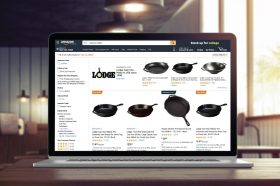Resources - Blog
How CPG Brands Can Optimize for Long-Term Profitability on Amazon

Stay on top of the latest e-commerce and marketplace trends.
Over the last year or so, a term that was once intended for Amazon’s internal use has become commonplace amongst day-to-day e-commerce lexicon. “CRaP” is an acronym that stands for “Can’t Realize any Profit,” the items that Amazon refers to as unprofitable to be sold in its retail channel.
One specific segment, consumer packaged goods (CPG), has been hit hard by Amazon’s CRaP policies. In this post, we explain how CPG brands can prevent being “CRaPped out” by the e-commerce leader and optimize their product packaging for sustainability and efficiency moving forward.
When Does Amazon Classify an Item as Unprofitable?
There are several potential reasons that could lead Amazon to deem an item as unprofitable:
1. Retail pricing and shipping economics: This is extremely common and what ends up plaguing CPG brands the most. The pricing configurations on traditional pack sizes are usually off if they are not optimized to be sold in an online environment. Amazon has encouraged vendors to lower prices and adjust packaging in order to help the items sell better online.
2. Surplus inventory: Certain items can become overstocked due to a spike in demand that typically evens out over time. If that overstock situation lasts for a long period of time, Amazon will likely decrease the price to increase sales velocity, which, in turn, can make an item unprofitable for the company.
3. Lack of price parity across other marketplaces and online retailers: Although Amazon has rolled back its price parity policy for third-party sellers, the company can still leverage pricing across other websites to determine how it prices branded goods. If your product is available for less on another website, Amazon will identify that price and match it. With some products, even coming within variance of a dollar to the other marketplace or website could deem your item unprofitable.
How CPG Brands Can Avoid the CRaP List and Optimize Product Packaging
If you are a brand who has not yet begun selling on Amazon, make sure to design any products you wish to sell for an online selling landscape. Reconsider simply carrying over your offline offerings to Amazon and, instead, analyze how you can rework pack sizes and product configurations to sell better on a digital shelf. Aim to find the optimal balance between supporting your traditional channels and adapting to new sustainable distribution models.
If you are already running an Amazon operation, make optimizations and concessions to meet Amazon’s need to incorporate “sustainable packaging that delights customers, eliminates waste, and ensures products arrive intact and undamaged.” Think green, sturdy, and inexpensive product packaging and avoid bulky or expensive packaging and handling.
Household names like Tide and Seventh Generation are two brands who have successfully improved their product packaging to become compliant with Amazon’s new standards. Tide launched a product known as the Eco-Box, which contains an ultra-concentrated detergent created specifically for e-commerce. It is designed to drive a lighter shipping footprint, ships in a sealed cardboard box, and contains less packaging and 60% less plastic than the current 150-ounce Tide press-tab box.
Through its parent company, the detergent brand has launched a specific task team, Procter & Gamble’s Fabric Care E-Commerce Innovation Group. The group is intended to address the unique challenges and opportunities the e-commerce landscape presents through product innovation.
Seventh Generation also took the initiative to revamp its packaging by bottling the detergent in a revolutionary bottle, known as the EasyDose, that is made with 60% less plastic and 50% less water compared to the standard 100-ounce. detergent bottle. Launched as an e-commerce exclusive, the detergent’s smaller and lighter packaging will allow for less damage while in transit to the end user and more efficient shipping given that it is no longer bulky or oversized.
What Are the Implications for Brands?
Beginning on Aug. 1, 2019, manufacturers with products identified for Amazon’s product packaging improvement program will be charged an additional fee $1.99 per non-compliant item shipped. If you upgrade your packaging to meet the requirements prior to the deadline, you will receive a credit of $1.00 per item shipped.
Outside of Amazon’s push for profitability, the company is instilling this policy to demonstrate its renewed commitment to reducing packaging waste and shipping costs, and brands want to mimic this strategy. According to Multichannel Merchant, 80% of merchants said they are actively working to reduce the amount of packaging material they use.
If you are a brand on Amazon, particularly in the CPG space, take a second look at your packaging’s design, eco-friendliness, size, and raw materials. When building out your strategy, make sure that the solution you land on reduces the amount of raw material used and still protects the item, all while providing a positive customer experience.
Learn what Feedvisor can do for your business.
When you partner with Feedvisor, you automatically receive access to our true, AI-driven technology and hands-on team of e-commerce experts. Contact one of our team members today to learn more about our end-to-end solution for brands and large sellers on Amazon, Walmart, and e-marketplaces.



